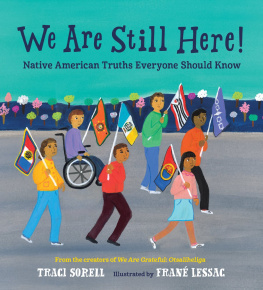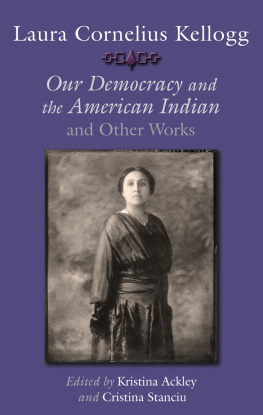Bureau of Indian Affairs
Donald L. Fixico

Copyright 2012 by ABC-CLIO, LLC
All rights reserved. No part of this publication may be reproduced, stored in a retrieval system, or transmitted, in any form or by any means, electronic, mechanical, photocopying, recording, or otherwise, except for the inclusion of brief quotations in a review, without prior permission in writing from the publisher.
Library of Congress Cataloging-in-Publication Data
Fixico, Donald Lee, 1951
Bureau of Indian Affairs / Donald L. Fixico.
p. cm. (Landmarks of the American mosaic)
Includes bibliographical references and index.
ISBN 978-0-313-39179-8 (hardcopy : alk. paper) ISBN 978-0-313-39180-4 (ebook) 1. United States. Bureau of Indian AffairsHistory. 2. Indians of North AmericaGovernment relations18691934. 3. Indians of North AmericaGovernment relations1934 4. United StatesRace relations. I. Title.
E93.F513 2012
323.1197dc23 2011036170
ISBN: 978-0-313-39179-8
EISBN: 978-0-313-39180-4
16 15 14 13 12 1 2 3 4 5
This book is also available on the World Wide Web as an eBook.
Visit www.abc-clio.com for details.
Greenwood
An Imprint of ABC-CLIO, LLC
ABC-CLIO, LLC
130 Cremona Drive, P.O. Box 1911
Santa Barbara, California 93116-1911
This book is printed on acid-free paper 
Manufactured in the United States of America
Recent Titles in Landmarks of the American Mosaic
Abolition Movement
T. Adams Upchurch
Chinese Exclusion Act of 1882
John Soennichsen
Tuskegee Airmen
Barry M. Stentiford
Wounded Knee Massacre
Martin Gitlin
To all my relatives of my four tribes, the Shawnee, Sac and Fox, Muscogee Creek, and Seminole.
Contents
Series Foreword
The Landmarks of the American Mosaic series comprises individual volumes devoted to exploring an event or development central to this countrys multicultural heritage. The topics illuminate the struggles and triumphs of American Indians, African Americans, Latinos, and Asian Americans, from European contact through the turbulent last half of the 20th century. The series covers landmark court cases, laws, government programs, civil rights infringements, riots, battles, movements, and more. Written by historians especially for high school students on up and general readers, these content-rich references satisfy more thorough research needs and provide a deeper understanding of material that students might only otherwise be exposed to in a short section in a textbook or superficial explanation online.
Each book on a particular topic is a one-stop reference source. The series format includes
Introduction
Chronology
Narrative chapters that trace the evolution of the event or topic chronologically
Biographical profiles of key figures
Selection of crucial primary documents
Glossary
Annotated Bibliography
Index
This landmark series promotes respect for cultural diversity and supports the social studies curriculum by helping students understand multicultural American history.
Introduction
Donald L. Fixico
Arizona State University
The Bureau of Indian Affairs (BIA) has a very long history of varying relationships with American Indians and Alaska Natives in the United States. In the early years, the BIA was called the Indian Office, and in later years it has been referred to as the Indian Bureau. Originally, the Department of War housed Indian affairs, but this responsibility shifted to the Department of the Interior when Congress created the department in 1849. The commissioner of Indian affairs presided over the BIA until 1978 when a higher level position of assistant secretary of the Interior took its place. Forty-seven men have served as the commissioner of Indian affairs, and 16 have served as assistant secretary, with the exception of Ada Deer being the only woman. The commissioner and later the assistant secretary were named by the secretary of the Interior and appointed by the president of the United States.
This book presents an overview of the history of the Bureau of Indian Affairs that spans more than 200 years of relations between the United States government and more than 500 American Indian tribes and Alaska Native groups. Key individuals, both Indian and non-Indian, forged an official relationship between the tribal nations and the United States that resulted in an official liaison called the Bureau of Indian Affairs. This volume covers the early U.S.-Indian relationship in the late 1700s of treaty and trade negotiations to Indian removals and wars that involved Eastern and Western Indian groups, leading to various policies. Such policies included boarding schools, Indian health, a reform movement, land allotment, termination, relocation, self-determination, and government-to-government recognition of tribal sovereignty. As relations with more Indian nations increased, the Indian Bureau expanded with agents throughout Indian Country. These relations resulted in 374 U.S.-Indian ratified treaties.
The organization of the Bureau of Indian Affairs is addressed here as well, and the long history of the Indian Office is briefly introduced in meaningful periods to readers to demonstrate the many changes and transitions that the BIA made to administer over 500 tribal nations.
Basically, the bureaus history can be divided into several periods of creation, early treaty negotiations, the removal years, treaties with western tribes, the reform years, the boarding school era, federal management of natural resources and lands, termination and relocation programs, education, self-determination, and tribal self-governance. It is important to view the BIA within a context of historical events and noted individuals who defined and shaped the course of federal-Indian relations. As Indian history unfolded, the BIA served as a liaison representing the federal government but not necessarily defining history. This is not to say that the BIA did not have its own history, but rather it had a proper place within the larger picture of Indian-white relations, because the operations of the BIA affected not only Indians and tribes but also non-Indians, land companies, railroads, mining companies, ranchers, and other agencies of the federal government.
Before reading the following pages, two important questions should be asked: what is tribal sovereignty, and why are treaties important?
Sovereignty, treaties, and the trust relationship make American Indians uniquely different than anyone else in the United States because their nations have signed nearly 400 treaties and agreements with the federal government. Due to the international doctrine of law, sovereigns respect sovereigns in treaty agreements. This relationship is based on a reciprocal trust status that is maintained by both sovereigns. Thus, the U.S. government has a responsibility to live up to the treaties and carry out their provisions, obligations, and promises.
The Indian Bureau cannot officially make Indian policy, but it can recommend policies and programs. Congress and the president of the United States make federal-Indian policy for the BIA to supervise. How it is carried out is up to the BIA. This situation creates a difficult challenge of being criticized much more than praised for its work. Naturally the commissioners or assistant secretaries since 1978 have played a vital role in leading the BIA. And he or she has to depend on other officials, including area office directors, to carry out the details of supervision and work with native leaders and their tribal communities.








